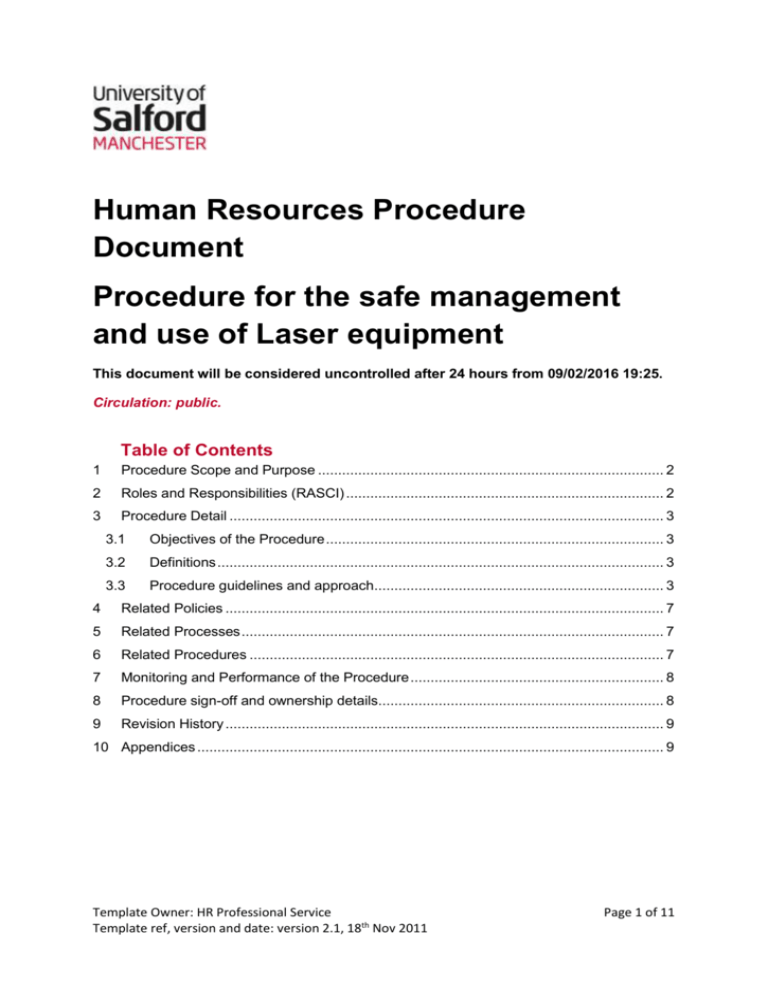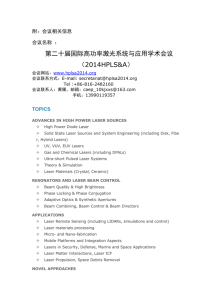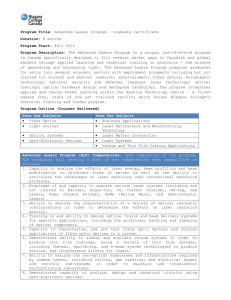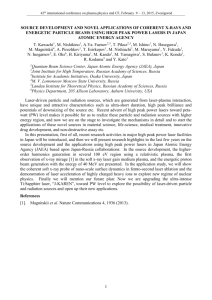Laser Procedure - the University of Salford
advertisement

Human Resources Procedure Document Procedure for the safe management and use of Laser equipment This document will be considered uncontrolled after 24 hours from 09/02/2016 19:25. Circulation: public. Table of Contents 1 Procedure Scope and Purpose ...................................................................................... 2 2 Roles and Responsibilities (RASCI) ............................................................................... 2 3 Procedure Detail ............................................................................................................ 3 3.1 Objectives of the Procedure .................................................................................... 3 3.2 Definitions ............................................................................................................... 3 3.3 Procedure guidelines and approach........................................................................ 3 4 Related Policies ............................................................................................................. 7 5 Related Processes ......................................................................................................... 7 6 Related Procedures ....................................................................................................... 7 7 Monitoring and Performance of the Procedure ............................................................... 8 8 Procedure sign-off and ownership details....................................................................... 8 9 Revision History ............................................................................................................. 9 10 Appendices .................................................................................................................... 9 Template Owner: HR Professional Service Template ref, version and date: version 2.1, 18th Nov 2011 Page 1 of 11 1 Procedure Scope and Purpose Scope and Purpose: Implications of non adherence Start point of the Procedure: End Point of the Procedure: Compliance and Regulatory requirements: Who uses this process: This procedure lays out the University approach to managing the risks from the use of lasers as required by the Control of Artificial Optical Radiation at Work Regulations (AOR) 2010. The laser beam may cause eye or skin injury to the operator or bystanders. The damage it causes depends on the power or energy and wavelength of the laser beam, the size of the beam and the part of the body it strikes. Other hazards, known as nonbeam hazards, include high voltages, fire, fumes from materials processing, liquid cooling systems, the weight of the laser and its associated support systems and mechanical hazards. Some lasers use chemicals that may be toxic or carcinogenic. The University may face prosecution if it can be shown there are insufficient control measures in place to manage the risks. The procedure applies to any laser used on University Business both on and off University premises. N/A The Control of Artificial Optical Radiation at Work Regulations (AOR) 2010. The Health and Safety at Work Act 1974. The Management of Health and Safety at work Regulations 1999. Anyone who uses a laser however the higher risk equipment will usually be in laboratories and controlled by the Schools H&S or Laser Coordinator. 2 Roles and Responsibilities (RASCI) Position(s) Responsible i.e. which position is responsible for ensuring that this procedure operates as required on a daily basis Accountable i.e. which one position in the University is accountable for ensuring that this procedure is applied correctly Supporting i.e. which positions are involved in delivering the procedure Head of School or Professional Service, Laser Safety Officers The Registrar Head of School / Professional Service, School Laser Safety Officer, Template Owner: HR Professional Service Template ref, version and date: version 2.1, 18th Nov 2011 Page 2 of 11 Consulting i.e. which positions need to be consulted if changes in the procedure are considered Informing i.e. which positions need to be informed about changes in the process School Health and Safety Officer, University Safety Officer Laser Safety Officers, School Health and Safety Officer, University Safety Officer Laser Safety Officers, School Health and Safety Officer, University Safety Officer, Technicians, Operators (staff and student). 3 Procedure Detail 3.1 Objectives of the Procedure Some forms of artificial light have the potential cause harm to operators if used without adequate precautions. This can include temporary and permanent damage to the skin and eyes and in the case of more powerful machines, burns or amputation. There is a legal and moral duty for the University to control this risk to anyone who could be affected by it. This procedure gives guidance on how to prevent injuries or health effects through a risk assessment based management system. 3.2 Definitions AOR - For the purpose of this document the term Artificial Optical Radiation (AOR) refers to the description as defined within CAORWR: ‘any electromagnetic radiation in the wavelength range between 100nm and 1mm which is emitted by non-natural sources’ [1] CAORWR - The Control of Artificial Optical Radiation at Work Regulations 2010 which came into force on 27 April 2010. A full copy of the regulations can be found here. DLO – Designated Laser officer. HOS/P Head of School / Professional Service HSC – Health and Safety Coordinator. HS&W – Health, Safety and Wellbeing. Template Owner: HR Professional Service Template ref, version and date: version 2.1, 18th Nov 2011 Page 3 of 11 3.3 Procedure guidelines and approach Roles and Responsibilities Head of School or Professional Service The HOS/P is responsible for ensuring the appointment of a suitable Laser Safety Officer when one is required. They are also responsible for making sure risk assessments are suitable and sufficient for any lasers used in their School. The HOS/P is also responsible for ensuring only competent persons use laser equipment within their area. These tasks can be delegated in part to the DLO, however, ultimate responsibility for ensuring these measures are in place remains with the HOS/P. Designated Laser Officer (DLO) For the purpose of this document, the DLO is the person who “owns” the laser, or has responsibility for managing its use. Where lasers above class 2 are present a DLO must be appointed from the School who either own or are intending to use the laser. The role of the DLO is to ensure that the lasers are safe and used as per current legislation and best practice. The DLO should have experienced and /or qualifications in the use of lasers and have a sufficient knowledge of the CAORWR to ensure its requirements are met. The DLO should carry out risk assessments on lasers in their area which should take into account the risks outlined in the ‘Risk Assessment’ section below. Maintenance schedules and registers must also be arranged and monitored by the DLO. Records of any maintenance and repair should be kept by the DLO. Health Safety and Wellbeing HS&W will ensure registers are kept by the DLO/HSC of all lasers above class 2. Where appropriate, HS&W will also assist with risk assessments and subsequent actions carried out by the HSC and DLO’s and will provide support and advice to HOS/P. HS&W will audit Schools / Professional Services to ensure safe systems of work are suitable and sufficient and are being adhered to and registers of lasers are kept up to date. Health surveillance will be provided by HS&W where it is deemed a necessary control measure as part of a risk assessment. Health and Safety Coordinator Template Owner: HR Professional Service Template ref, version and date: version 2.1, 18th Nov 2011 Page 4 of 11 The HSC will coordinate and maintain a register of lasers in their School or Professional Service, in consultation with the DLO, and oversee that the duties outline in this document are being fulfilled; and appropriate safety records are being maintained. Where a DLO is not required, the HSC is responsible for ensuring any lasers used within their area are risk assessed and adequate control measures are in place to control any hazards. The Safety Coordinator is responsible for keeping up to date records of the number, type and location of all laser equipment in their area. Any risk assessment relating to laser use should be carried out or checked by the safety coordinator. Copies of these risk assessments must also be held by the Safety Coordinator and reviewed annually or whenever a significant change in use, setup or procedure takes place. These risk assessments will also form part of the external health and safety audit. The coordinator should also work closely with academics and students who use the equipment and ensure procedures for safe operation are distributed and followed. Maintenance records should be held by the safety coordinators as well as any repair or damage reports where a DLO is not appointed. Existing Lasers Existing lasers must be assessed to ensure they do not pose a risk in their existing environment. New Lasers When purchasing a new laser it is essential to use the lowest class of laser which will fulfil the intended use. Once purchased the School’s Health and Safety Coordinator should be informed and a risk assessment carried out prior to the laser being used. Any class 3B or Class 4 lasers need to be added to the University inventory and the DLO informed prior to their commissioning. Procedure This procedure should be applied to both existing and newly acquired laser equipment. The CAORWR requires that a risk assessment is made of all laser equipment and stipulates information which should be included / considered in this assessment. The risk assessment should be carried out on the standard University template which can be found at the following link: http://www.salford.ac.uk/hr Template Owner: HR Professional Service Template ref, version and date: version 2.1, 18th Nov 2011 Page 5 of 11 Additional information is required which can then be listed on the form provided at the end of this document (section 10). This procedure mainly refers to higher risk class 3B and class 4 lasers however the use of lower class laser equipment such as laser pointers can pose some degree of risk and should be assessed in a similar fashion however a generic risk assessment for this type may be more practical i.e. for laser pointers used during lectures. [1] http://www.legislation.gov.uk/uksi/2010/1140/regulation/1/made - Downloaded 6/12/2010 Lasers should be supplied with their classification clearly stated in accordance with BS EN 60825:1 (2007). For more information about laser classification please see the following document (Athens password required); https://bsol.bsigroup.com/en/Bsol-Item-Detail-Page/?pid=000000000030187909 When purchasing a new laser it is essential to use the lowest class of laser which will fulfil the intended use. Once purchased the School’s Health and Safety Coordinator should be informed and a risk assessment carried out prior to the laser being used. Any class 3B or Class 4 lasers need to be added to the University inventory and the DLO informed prior to their commissioning. For all areas with lasers above Class 2 an appointed person within the school should be designated to oversee that the safe use of lasers is maintained and meets current best practice. Risk Assessment. A written risk assessment should be completed for all lasers above class 2 using the standard University risk assessment form which can be found here: http://www.salford.ac.uk/pod The following should be taken into account when completing this assessment: 1. 2. 3. 4. 5. 6. 7. 8. 9. The effect of exposure. The effects of exposure on specific higher risk groups. Risk from photosensitising chemical substances in contact with the laser. Any indirect effects of exposure. Availability of alternative equipment designed to reduce levels of exposure. Is health surveillance required? Are there multiple sources of exposure? Fire risk. Any other associated risks such as electrical or heat. Template Owner: HR Professional Service Template ref, version and date: version 2.1, 18th Nov 2011 Page 6 of 11 Control Measures. The following control measures should be considered when risks are identified. 1. 2. 3. 4. 5. A lower class of laser should be used wherever possible. A safe system of work for higher risk lasers may be necessary. Restrict access to authorised operators. Isolate / lockout the laser when not in use. Protective measures such as interlocks / filters / screens / remote controls / remote viewing. 6. Train operators in best practice. 7. Signage and demarcation of laser areas. 8. Keep equipment well maintained. 9. Use appropriate PPE such as goggles and protective clothing. Goggles should meet or exceed EN207 standards for general use and EN208 during any alignment of lasers where the risk is higher. 10. Keeping combustible materials away from sources of ignition. 11. Consider installing extraction for any fumes which may be generated by laser cutting etc. These measures are a guide and not exhaustive. Additional measures may be required as determined by the risk assessment. 4 Related Policies Policy Name University Health and Safety Policy. Fire Policy – Managing the Risk. Laboratories Cleaning and Maintenance. Location http://www.salford.ac.uk/hr 5 Related Processes Process Name N/A Location N/A 6 Related Procedures Procedure Name Risk Assessment Code of Practice. Location http://www.salford.ac.uk/hr Template Owner: HR Professional Service Template ref, version and date: version 2.1, 18th Nov 2011 Page 7 of 11 7 Monitoring and Performance of the Procedure Records: Monitoring application of the Procedure: Performance Indicators: Training and Support for the Procedure: Copies of any written risk assessments should be kept by the Laser Officer and/or the Schools Safety Coordinator. Any safe systems of work need to be available for all operators. Maintenances schedules and records should be held by the Laser Officer. Monitoring will be as part of regular safety inspections carried out by School Safety Coordinators and Laser Officers and as part of the School’s / Professional Service’s Audit. Not applicable Laser officers will need to be aware of this procedure and relevant legislation. 8 Procedure sign-off and ownership details Document name: Procedure for the safe management and use of Laser equipment Version Number: 2 Status: Working Equality Impact Assessment: Completed Mar 2011 Approved by: Effective from: Date for Review: January 2013 Author: Dave Lamb Owner: Document control: All printed versions of this document are classified as uncontrolled. A controlled version of this document is available from Human Resources. Questions on this process should be initially directed to Health Safety & Wellbeing. Template Owner: HR Professional Service Template ref, version and date: version 2.1, 18th Nov 2011 Page 8 of 11 9 Revision History Release Number 2 Date Revision description Author July 2011 Minor amendment to responsibilities Dave Lamb 10 Appendices Further Information; The Association of University Radiation Protection Officers - Lasers – Guidance Note: http://www.aurpo.org/docs/AURPO_GN7_Lasers_0107.pdf CLASS MEANING Old Classification New Classification Class 1 Normally Safe 1 1 1M Class 2 Class 3 Eye protected by aversion response (visible only) 2 Eye hazard 3A & 3B* 2M 3B Class 4 Class 1 Class 1M Class 2 Class 2M Class 3R Class 3B Class 4 Eye and skin hazard 2 3B 4 Reason for Change 1M - diverging/low power density devices that could be hazardous if beam focussed 2M - diverging/low power density devices that could be hazardous if beam focussed 3R Low eye hazard, power density restriction removed 3B No significant change 4 No significant change Safe. Safe provided optical instruments are not used. Visible lasers. Safe for accidental exposure (< 0.25 s). Visible lasers. Safe for accidental exposure (< 0.25 s) providing optical instruments* are not used. Not safe. Low risk. Hazardous. Viewing of diffuse reflection** is safe. Hazardous. Viewing of diffuse reflection is also hazardous. Fire risk. Template Owner: HR Professional Service Template ref, version and date: version 2.1, 18th Nov 2011 Page 9 of 11 *Optical instruments - binoculars, telescopes, microscopes, magnifying glasses (but not prescription glasses). **Diffuse reflection - the reflection of radiation from a matt surface such as a wall. Please complete the following table and attach it to the risk assessment form for the individual piece of equipment. AOR Risk assessment form. Manufacturer Model Location Class 3B or Class 4 Laser? Level Wavelength Duration Exposure limit values Template Owner: HR Professional Service Template ref, version and date: version 2.1, 18th Nov 2011 Page 10 of 11 LASER INSPECTION FORM. Date; Room No; Building; Completed by; Make; Model; Serial No; Precautions Remote Interlock Key Control Emission indicator Beam Shutter Beam Stop Beam Level Beam Enclosure Eye Protection Protective Clothing Eye Examinations Training Laser Labels Door Signs Type; Mode; l Max Power; Class 1 Class 2 Class 3R Class 3B Class 3B Class 4 Class 1(E) Authorised Users; (please list) Current Risk Assessment completed; (please tick) Yes No Risk Assessment review date; Administrative controls; (Based on risk assessment) Further recommendations; Template Owner: HR Professional Service Template ref, version and date: version 2.1, 18th Nov 2011 Page 11 of 11






